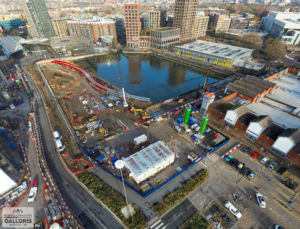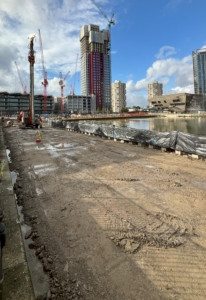CASE STUDY
Client: Galldris
Project: Canada Water Dock, London
Deep Soil Mixing Ltd has successfully completed a project for their client Galldris, to provide a low-level promenade that would promote a relaxing amphitheatre for pedestrians. The promenade had to accommodate a wide variation in loading from seating, plantation zones and a bridge landing area and all of this in the reclaimed area of the historical docks of Canada Water London, part of The Canada Water Masterplan.
The Canada Water Masterplan is a partnership between British Land, Southwark Council, and the local community to create an outstanding new town centre for Southwark and London that compliments the local area, making an active, positive, long-term contribution to local life. The first phase of this Masterplan includes several plots, along with public realm and infrastructure works.
Galldris were awarded the infrastructure framework partnering with British Land, expected deliver up to 3,000 new homes, two million sq ft of workspace and one million sq ft of retail, leisure, entertainment and community space including proposed health and social infrastructure, and educational uses.
Over the course of approximately five months, from October 2023 until February 2024, Deep Soil Mixing Ltd worked closely with Galldris to deliver the necessary ground improvement solutions and reduce long-term settlement of the upfilled land in the dock. This allowed work to begin on the restoration of Canada Water’s rich wetland habitat and construction of a new boardwalk, steps down to the water, amphitheatre, dipping pond and pergola.
The mass soil mixed slab resulted in a stable platform to work from initially and then provided the means to distribute the soil mixed load into the columns that were installed though the platform to increase the loadbearing capacity of the soil and reduce the settlement to provide the necessary support for the restoration works.
The Solution
The old unused dock was built in 1876 and the site needed to be infilled to a level just above dock water level, then stabilised to ensure settlement of the new promenade was able to meet the stringent settlement criteria of 10mm.
The soil mixed design for the project included a mass stabilised platform with soil mixed columns supporting the 800m2 of soil mixed slab. The use of the initial soil mixed slab avoided the need for a working platform for the soil mixed column rig to install the soil mixed columns, something that other piling methods would have required.
The mass soil mixed platform served initially as the temporary working platform before becoming a key part of the main design to distribute the various loads through the installed columns.
The Project
Once the soil mixed platform was in place, the columns were installed to depths of 10-11m through the platform. This provided the required soil strength and stability as well as a reduction in the settlement of the upfilled land in the dock.
Mass soil mixing has the benefit of design flexibility if needed. When obstructions were found during the project work, the design was adapted from 1.5m columns to 1m columns to enable the successful completion of the project with minimal disruption.
As a result of the deep soil mixing methods, the transformation of the old dock was supported. Canada Water’s rich wetland habitat was restored, and the site was enhanced with the newly constructed features – a new boardwalk across the dock and steps down to the water’s edge were built together with the amphitheatre, dipping pond and pergola to enhance the site.
Quality Assurance
Deep Soil Mixing Ltd provides quality assurance with each and every project undertaken – as the recently completed mass mixing of the site ground and installation of the platform and columns at Canada Water Dock in London demonstrates.
Quality is guaranteed as a result of the technology, method and ongoing monitoring that takes place as standard.
All details relevant to the soil mixing undertaken is logged and regularly monitored using our column installation method and our field- and laboratory-based test results. Important information such as mixing tool type, binder specifics, mixing depth, mixing pressure, flow rate and mixing head rotation, are closely and regularly checked to ensure the right binder consistency is used and that all the requirements of the build design are met.
Throughout the project, checks are made on the stability and strength of the mixed soils using core drilling at the relevant soil sections and depths to get the samples – these are then tested at the laboratory to make sure the required soil consistency has been achieved site-wide.
Images Copyright Permission – Galldris Services Ltd
What are the benefits of using soil mixing?
Environmentally Friendly & Economical: Natural resources are spared as existing soil is used as aggregates. Many forms of contaminated ground can also be mixed which reduces transportation of raw materials to landfill. The use of soil mixing can also reduce construction programme and reduces carbon footprint with less vehicular movements.
Flexible: Effective on different soils, including soft soils, flood plains, contaminated land, peat, silts and alluvium etc. Flexibility also in design and application as well as installation of the soil mix not being affected by the weather. The final cured product can also be shaped, benched or battered to suit.
Reduces Construction Programme
Improved health and safety due to less vehicle movements on site
Reduced Vibration: Soil Mixing induces very low vibrations, which reduces the potential impact to nearby utilities. The equipment does not exert any lateral pressure when mixing we can work as close as 200mm from the building/foundations
Increases bearing pressure, controls settlement and reduces permeability.
Wide range of soils can be treated compared to other solutions
No need to bring costly and bulky materials on site







